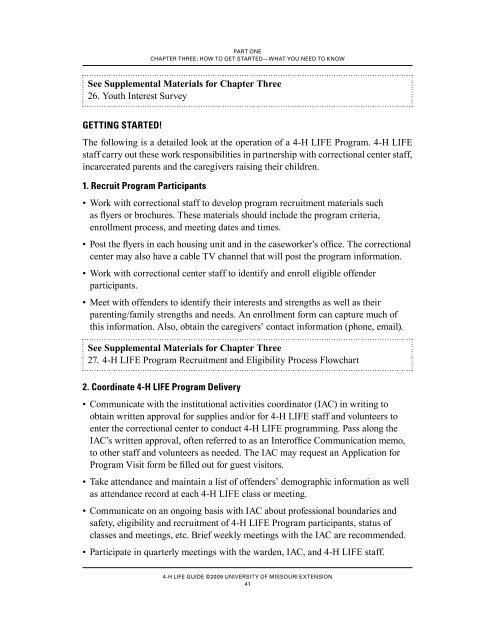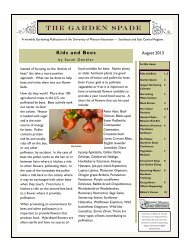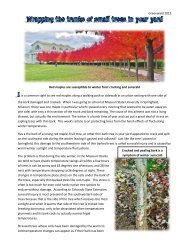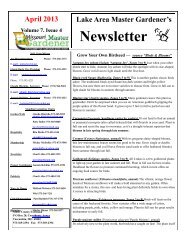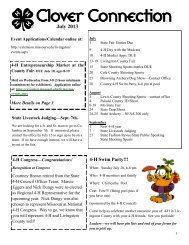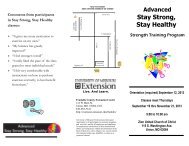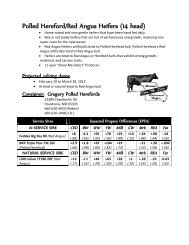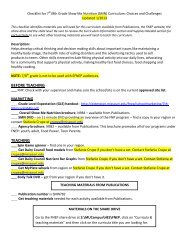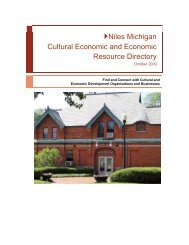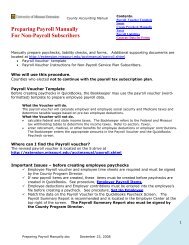A Program for Children with Incarcerated Family Members (PDF)
A Program for Children with Incarcerated Family Members (PDF)
A Program for Children with Incarcerated Family Members (PDF)
You also want an ePaper? Increase the reach of your titles
YUMPU automatically turns print PDFs into web optimized ePapers that Google loves.
PART ONE<br />
CHAPTER THREE: HOW TO GET STARTED—WHAT YOU NEED TO KNOW<br />
See Supplemental Materials <strong>for</strong> Chapter Three<br />
26. Youth Interest Survey<br />
GettInG started!<br />
The following is a detailed look at the operation of a 4-H LIFE <strong>Program</strong>. 4-H LIFE<br />
staff carry out these work responsibilities in partnership <strong>with</strong> correctional center staff,<br />
incarcerated parents and the caregivers raising their children.<br />
1. recruit <strong>Program</strong> Participants<br />
• Work <strong>with</strong> correctional staff to develop program recruitment materials such<br />
as flyers or brochures. These materials should include the program criteria,<br />
enrollment process, and meeting dates and times.<br />
• Post the flyers in each housing unit and in the caseworker’s office. The correctional<br />
center may also have a cable TV channel that will post the program in<strong>for</strong>mation.<br />
• Work <strong>with</strong> correctional center staff to identify and enroll eligible offender<br />
participants.<br />
• Meet <strong>with</strong> offenders to identify their interests and strengths as well as their<br />
parenting/family strengths and needs. An enrollment <strong>for</strong>m can capture much of<br />
this in<strong>for</strong>mation. Also, obtain the caregivers’ contact in<strong>for</strong>mation (phone, email).<br />
See Supplemental Materials <strong>for</strong> Chapter Three<br />
27. 4-H LIFE <strong>Program</strong> Recruitment and Eligibility Process Flowchart<br />
2. Coordinate 4-H LIFe <strong>Program</strong> delivery<br />
• Communicate <strong>with</strong> the institutional activities coordinator (IAC) in writing to<br />
obtain written approval <strong>for</strong> supplies and/or <strong>for</strong> 4-H LIFE staff and volunteers to<br />
enter the correctional center to conduct 4-H LIFE programming. Pass along the<br />
IAC’s written approval, often referred to as an Interoffice Communication memo,<br />
to other staff and volunteers as needed. The IAC may request an Application <strong>for</strong><br />
<strong>Program</strong> Visit <strong>for</strong>m be filled out <strong>for</strong> guest visitors.<br />
• Take attendance and maintain a list of offenders’ demographic in<strong>for</strong>mation as well<br />
as attendance record at each 4-H LIFE class or meeting.<br />
• Communicate on an ongoing basis <strong>with</strong> IAC about professional boundaries and<br />
safety, eligibility and recruitment of 4-H LIFE <strong>Program</strong> participants, status of<br />
classes and meetings, etc. Brief weekly meetings <strong>with</strong> the IAC are recommended.<br />
• Participate in quarterly meetings <strong>with</strong> the warden, IAC, and 4-H LIFE staff.<br />
4-H LIFE GUIDE ©2009 UNIVERSITY OF MISSOURI EXTENSION<br />
41


